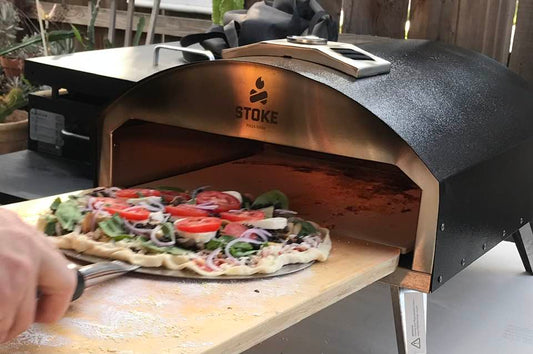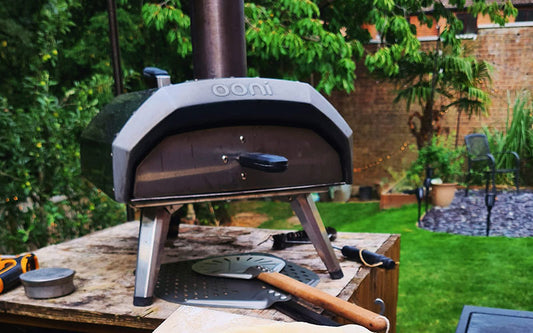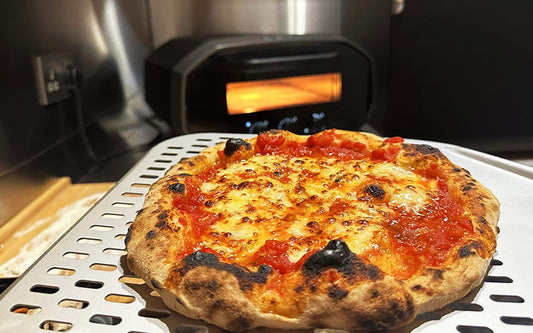I’m sure a lot of us consume a gazillion of marinara and pizza sauce throughout our lifetime. But have you ever stopped to wonder what makes these two sauces so different? In this blog post about marinara vs pizza sauce, I’ll outline the key differences between these two popular sauces.
Marinara is usually thicker and chunkier than pizza sauce. To make it, you need to slowly simmer peeled tomatoes with herbs and seasoning on the stovetop for about 15-25 minutes. A traditional pizza sauce is made by just blending whole peeled tomatoes with herbs and seasoning in a food processor or blender.
So if you want to know more about the differences between marinara and pizza sauce, then read on! I’ll be sharing all my hard-earned baking knowledge to help you master the art of making both sauces.
All About the Classic Marinara Sauce
Marinara sauce is a classic tomato-based sauce commonly used in Italian cuisine. As someone who loves all things tomato-y, it’s a pantry staple at my house.
The origins of marinara sauce can be traced back to Naples, Italy. It was created as a simple and flavorful way to dress pasta dishes. The name “marinara” actually translates to “sailor-style”. It refers to the fact that the sauce was often made by sailors using ingredients they had on hand while at sea.
The basic ingredients for marinara sauce include tomatoes, garlic, olive oil, salt & basil. Some recipes may also call for onions or red pepper flakes to add extra flavor and spice. When making marinara sauce from scratch, it’s important to use high-quality tomatoes.
One of the key characteristics of marinara sauce is its smooth texture. The tomatoes are crushed into a smooth consistency before being simmered. This creates a thick and velvety texture that coats pasta and pizza crusts perfectly.
In terms of taste, marinara sauce is known for its tangy flavor profile. The vibrant tomatoes combined with the freshness of the herbs create a nice balance. It pairs well with many different types of toppings.
As someone who has experimented with making my own marinara sauce at home, I can attest to how easy it is to whip up a batch in no time. It’s a versatile sauce that can be used in many different ways beyond just pizza or pasta. Try using it as a dipping sauce for breadsticks or even as a base for soups or stews.
What Is a Classic Pizza Sauce?
Pizza sauce is a crucial component of any delicious pizza. Whether you prefer a classic New York style or an authentic Neapolitan pie. There’s no denying the fact that the right sauce can truly make or break your pizza.

A classic pizza sauce is typically made with canned tomatoes, olive oil, garlic, and herbs. Canned tomatoes have a more concentrated flavor. Hence, they are a better choice for this recipe than fresh tomatoes.
Neapolitan-style pizza sauce uses San Marzano tomatoes as its base. It’s a type of tomato that is native to Italy and known for its sweet and tangy flavor. The tomatoes are pureed and mixed with garlic, salt, and sometimes a pinch of red pepper flakes.
One of the key characteristics of a good pizza sauce is its thin and spreadable consistency. You don’t want it to be too thick or chunky. A lightly sweet and mildly tangy flavor profile is also important. It should complement the other flavors on your pizza rather than compete with them.
The best part about making your own pizza sauce is that it’s incredibly easy to do! With just a few simple ingredients and the help of a food processor or hand blender, you can whip up a batch in just a few minutes.
After experimenting with various pizza sauces over the years, I’ve learned that there’s no one “right” way to make it. It’s all about finding what works best for your personal tastes and preferences.
Pizza vs Marinara Sauce: The Key Differences
While marinara and pizza sauce may seem similar at first glance, there are several differences between these two.
1. Taste and Consistency
When it comes to pizza sauce and marinara sauce, there is a tangible difference in taste. Marinara sauce is thicker, chunkier, and has a more complex flavor profile.
Traditional pizza sauce is comparatively thinner but spicier. A good pizza sauce should never overpower the flavor of the crust and toppings.
2. Ingredients and Preparation Method
When it comes to marinara vs pizza sauce, another key difference lies in the type of tomatoes used.
Marinara Recipe
I have made marinara sauce countless times, and it is one of my favorite sauces to prepare. In Italy, there’s no marinara sauce without San Marzano tomatoes. They are grown in the volcanic soil around Mount Vesuvius.
To make the sauce, I start by blanching the tomatoes in boiling water and then peeling them. I then crush or blend the peeled tomatoes into a chunky consistency. In a large pot, I heat up some olive oil and sauté some garlic until fragrant.
Next, I add the crushed tomatoes to the pots. Then I add salt and let the sauce simmer on low heat for about 20 minutes to thicken and develop flavor.
Depending on the dish I am preparing, I may also add some dried oregano or parsley to the sauce for extra flavor. Low heat and the right tomatoes are the keys to making a good marinara.
Pizza Sauce Recipe
Pizza sauces can be either cooked or uncooked. The Neapolitan-style pizza sauce recipe I follow is uncooked. All you need is a blender and the right ingredients. For this recipe, you need to get your hands on sweet and juicy, mildly tangy tomatoes, ideally San Marzano.
Put the whole peeled tomatoes in the beaker. In goes some coarse sea salt, minced garlic, extra virgin olive oil, and dried oregano. Blend until the sauce is nicely emulsified.
Finish off with some chopped basil, and your sauce is ready. If you are using a different variety of tomatoes, you may add a pinch of baking soda or sugar to balance the acidity.
Some recipes would call for onions and simmering the sauce for 30 minutes on low heat. Slow simmering thickens up the sauce. This step is important if the sauce is meant for stuffed and deep-dish pizzas.
3. Versatility
Marinara sauce’s thickness and flavor profile make it a perfect sauce for spaghetti. It also works well as a dipping for breadsticks and deep-fried snacks. It’s also an important element in casseroles and stews.
If you have a lot of leftover pizza sauce, you can use it to brighten up your braised beef or curries. Or make salsa with it, put it in your sandwich, or toss your gnocchi in it. I often use up the leftover sauce as an all-purpose stir-fry sauce. Works like a charm!
Actually, both sauces are equally versatile. If you are going for bolder flavors, use marinara. And if you want to balance out your dish with acidity, you can use pizza sauce instead of tomato puree.
Can You Substitute Marinara for Pizza Sauce?
The short answer is yes, you can substitute marinara sauce for pizza sauce. Both sauces have similar almost ingredients, with tomatoes as the primary base. In fact, many Italian cooks use marinara sauce as a base for their pizzas.
Marinara sauce and pizza sauce have almost similar ingredients. However, the main difference between the two is consistency. Traditional pizza sauce has a looser consistency than marinara sauce. That’s because it is made from pureed tomatoes.
If you are in a pinch and do not have any pizza sauce on hand, using marinara sauce will work just fine. Just keep in mind that the flavor may be slightly different due to the difference in consistency. You can also add some extra herbs or spices to enhance the flavor.
I’d encourage you to use marinara instead of pizza sauce in the thick crust, overloaded pizzas. This is because its bolder flavor can hold up to the weight of the toppings better.
Is the vice versa possible as well? Well…
You can use pizza sauce as a substitute for marinara sauce in pasta dishes. But may not work as well due to its consistency. Marinara sauce is better suited for pasta dishes because it coats the pasta better.
If you have a lot of pizza sauce sitting in the fridge, I would suggest reducing it a bit on the stovetop before tossing your pasta, veggies, or protein in it.
In Conclusion
I hope this article helped you with your marinara vs. pizza sauce dilemma. Both sauces have their own unique set of ingredients and cooking methods. But the most important thing is to use quality ingredients. Experiment until you find what works best for you.
Paying attention to the details, like the type of tomato used and the cooking method, will make all the difference.
So go ahead and get creative in the kitchen after all, as I said before, your sauce, your rules!




